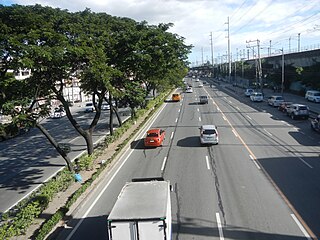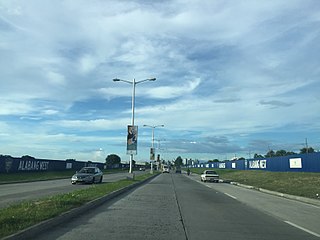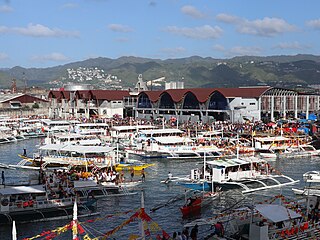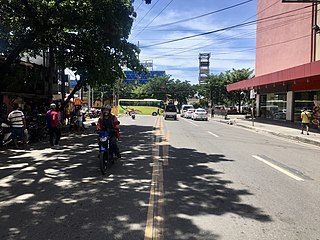
Don Vicente Rama Memorial National High School is a public secondary school in Cebu City in the Philippines.
The legislative districts of Cebu City are the representations of the highly urbanized city of Cebu in the various national legislatures of the Philippines. The city is currently represented in the lower house of the Congress of the Philippines through its first and second congressional districts.

The Marikina–Infanta Highway is a 117.5-kilometer (73.0 mi) highway that connects Quezon City, Metro Manila with Infanta, Quezon in the Philippines.

Aurora Boulevard is a four-to-ten-lane major thoroughfare in Quezon City and San Juan in Metro Manila, Philippines. It is named after Doña Aurora Quezon, the consort of Commonwealth President Manuel Luis Quezon. It is one of the major roads in the commercial district of Araneta City in Cubao. LRT Line 2 follows the alignment of the boulevard.

Osmeña Boulevard is a major arterial thoroughfare in Cebu City, Philippines. It is the city's "main street" which travels in a generally northwest–southeast orientation linking the old downtown district of San Roque near the harbor with the modern uptown Capitol Site district. Beginning at M.J. Cuenco Avenue in the east, the boulevard heads northwest towards Fuente Osmeña circle and ends at Escario Street. At its north end, the Cebu Provincial Capitol serves as a prominent terminating vista. It is the location of many of Cebu's notable institutions such as the Cebu Normal University, Abellana National School and Cebu Doctors' University Hospital; the Basilica of Santo Niño; one of the city's tallest buildings, Crown Regency Hotel; and shopping centers Robinsons Fuente and Gaisano Colon.

Daang Hari, also known as the Las Piñas–Muntinlupa–Laguna–Cavite Link Road, is a collector road that links southern Metro Manila to the province of Cavite in the Philippines. It begins as a north–south road from Commerce Avenue, just south of the Alabang–Zapote Road, running for 5.9 kilometers (3.7 mi) on the boundary of Las Piñas and Muntinlupa. It then runs east–west for about 9.2 kilometers (5.7 mi) from its junction with Daang Reyna, winding through Bacoor, Imus, Dasmariñas, and General Trias.

Colonel Bonny Serrano Avenue is a major east–west thoroughfare in the Eastern Manila District of Metro Manila, Philippines, between San Juan and Quezon City. It was named after the decorated Korean War hero Venancio "Bonny" Serrano.

The South Road Properties (SRP), also known as the South Reclamation Project, is a 300 ha reclamation area in Cebu City, Philippines. The area, which is reclaimed from Mactan Channel, is located off the coast of the southern district of Cebu City, near Barangays Mambaling, Inayawan, and Pasil. It spans from the shore of mainland Cebu to Kawit Point. An island-type reclaimed area, it is connected with mainland Cebu by the Cebu South Coastal Road and the Mambaling Access Road. Through the Cebu–Cordova Link Expressway, the SRP is also connected by land to Cordova and the island of Mactan.

National Route 129 (N129), or Route 129, is a secondary national route in Metro Manila that forms part of the Philippine highway network. Entirely located within Quezon City, it comprises Congressional Avenue, Congressional Avenue Extension, a portion of Luzon Avenue, a portion of Tandang Sora Avenue, and a portion of Katipunan Avenue; most of them are part of C-5 except the EDSA–Mindanao Avenue segment.

Elizabeth Mall, commonly known as E-Mall, is a shopping mall located in Cebu City, Philippines. It is owned by Atty. Augusto W. Go, Chairman of the Board & President of Cebu Central Realty Corporation who also owns University of Cebu and College of Technological Sciences–Cebu. It also calls itself as the "Shopping Center of the South".
Transportation within Cebu City is mainly land-based with most parts of the city accessible by road. There is no existing mass transit but construction is currently being undertaken on the Cebu Bus Rapid Transit System as well as an existing proposal for a Cebu Monorail, both of which will be crucial in solving the city's worsening traffic congestion, as existing transportation modes will soon become insufficient to move residents around the city if the local government fails to urgently implement infrastructure projects and measures to address the issue.

The Pasil Fish Market is a major fish market located in Barangay Suba, Cebu City, Philippines. Established in 1921, the market is a major market for fresh fish sourced throughout the seas of Visayas, such as Visayan Sea, Samar Sea, Camotes Sea, and Bohol Strait, among others.

F. Llamas Street is a national tertiary road in Cebu City, Cebu, Philippines. It commences at N. Bacalso Avenue in Barangay Basak San Nicolas, passes through the junction of Tres de Abril and E. Sabellano streets and ends at the junction of Katipunan Street in Barangay Tisa. It was formerly considered as a "national aid" city road under Executive Order No. 113 issued by President Ramon Magsaysay on May 2, 1955.
Katipunan Street is a national tertiary road in Cebu City, Cebu, Philippines. It commences at the corner of N. Bacalso Avenue and V. Rama Avenue in Barangay Calamba, passes through the junctions of A. Lopez and Salvador streets and ends at the junction of F. Llamas Street in Barangay Tisa.
Dr. Jose P. Rizal Street, also known as Jose Rizal Street, is a short local road in Cebu City, Cebu, Philippines. It commences at P. Burgos Street as a one-way lane passing through the Legislative Building of the Cebu City Hall and ends at D. Jakosalem Street.
C. Padilla Street is a national tertiary road in Cebu City, Cebu, Philippines. It commences at Colon Street in Barangay Pahina Central, passes through several junctions in Barangays San Niolas Proper, Pahina San Nicolas, Sawang Calero and Duljo-Fatima and ends at the junction of F. Vestil Street and L. Gabuya Street in Barangay Mambaling.
The Cebu South Bus Terminal (CSBT) is a bus station in Cebu City, Philippines. CSBT is operated by the Cebu Provincial Government with Carmen Quijano as its current operations manager. The station is a hub for buses servicing southern Cebu and nearby provinces such as Negros Oriental, Negros Occidental and the Zamboanga Peninsula.
The Cebu North Bus Terminal (CNBT) is a bus station in Cebu City, Philippines operated by the Cebu Provincial Government which serves as a hub for buses servicing northern Cebu. CNBT was previously located in a lot owned by the Mandaue city government in Barangay Subangdaku which was under a lease agreement with Cebu City government, which in turn granted the Cebu Provincial Bus Operators Multi-purpose Cooperative, Inc. (CPBOMCI) the management of the terminal.
National Route 81 (N81) is a 34.6-kilometer (21.5 mi), east-west primary route which forms part of the Philippine highway network in Cebu connecting the cities and municipalities of Naga, Toledo, Pinamungahan, Aloguinsan and Barili. Two roads form the route, namely the Naga−Toledo Road and the Uling−Toledo Wharf Road.

National Route 204 (N204) is a 388.06-kilometer (241.13 mi), two-to-four lane, secondary national road that forms part of the Philippine highway network. The route comprises several windy, mountainous, and often narrow and dangerous roads from the southwestern tip to the central regions of the Cordillera Mountain Range up until the province of Kalinga, and towards its western limits in Abra and Ilocos Sur.












